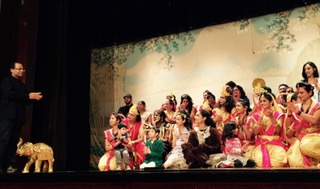Contribute
| SETU’s Ramayan Play Takes The Boston Audience On A Captivating Journey |
Shuchita Rao
10/26/2016
The Hindu epic “Ramayan†tells a moving story about Lord Rama (the son of Ayodhya’s King Dashrath) and his wife Sita. The story has been told through the medium of books and narrated through song and classical dances over decades. It was a pleasant surprise to see it in the form of an English language play staged multiple times on the weekend of Oct 21—23 in Belmont, MA. The SETU (Stage Ensemble Theatre Unit) production featured more than two dozen Boston based actors, dancers and support stage crew in the play written by a dozen of its own members. For SETU, a Boston based non-profit theatre group, this 13th successful production in a span of 13 years was yet another feather to add to its cap.
On a crisp Sunday Fall season afternoon, there was palpable excitement in the air when the spacious Belmont Town Hall theatre with large windows, a high ceiling and a raised stage went pitch dark. The spotlight fell on a tall, dark and friendly human dressed as a monkey who held a gleaming golden mace in his hands. Dressed in bright clothes, sparkling jewels and striking makeup he greeted the audience enthusiastically a little after 2pm. After briefly recounting the story of Ramayan for the benefit of those who did not know the story, he ended on the note “This play addresses how one must approach the most basic problems of our existence.â€
Through multiple swiftly changing scenes, the 2 hour 40 minute long play effectively captured the human aspect of the complex characters in the Ramayan story. A powerful script delivered effectively through nuanced oral recitation of dialogs by several actors evoked the emotions of fear, courage, anger and happiness in the members of the audience. Right in the first scene of the “Swayamwar†where the beautiful princess Sita chooses Ram, the crown prince of Ayodhya to be her husband, the audience was engaged and joyfully applauded the divine match. In watching a dejected Ravan, the fearless king of Lanka lose his bid for marrying Sita, the audience felt curious about how he would channel his desire for revenge. The scene involving the interaction of Queen Kaikaye with her advisor Manthara and subsequently with her husband King Dashrath were brilliantly executed. Lakshman’s characterization as an intense and impetuous younger brother of Ram suspecting danger and foul play at brother Bharat’s arrival to the forest was also well portrayed and evoked laughter from members of the audience. Young children pretending to be golden deer prancing around the aisles of the auditorium warmed hearts and the bird Jatayu’s valiant fight to protect Queen Sita evoked the emotion of sadness. Elementary school aged child Arnav Gupta in the audience said after watching Jatayu’s dance and Vali-Sugreeva fight “I loved how the fights were enacted in the play. They looked very real.â€
Jayanti Bandopadhyay, a founding member of SETU said at the beginning of the show “The attempt of this production was in looking at the human-ness of the characters. No one is a GOD. No one is a demon.†This goal came true when demoness Soorphanaka’s role enacted with passion caused a member of the audience, Swati Joshi to comment “Soorphanaka was great. It would be nice to read a book that explores her character in greater depth.â€
The management of sound and lights effectively created an atmosphere suited for a variety of scenes. The sound of chirping birds with green lights projected on a large fabric landscape backdrop made the stage appear like a verdant forest. The sound of a bee when demon king Ravan lays his eyes on the ascetic princess Sita and flickering lights to depict confusion when Ravan abducts Sita were mood enhancers. Attention to detail (such as Monkey Hanuman’s stooping stance to portray the quality of devotion and loyalty) showed the effort that went into planning every appearance on stage and every move made by an actor. Costumes and jewelery used in the presentation were flamboyant and graceful and deserve special mention. Jayanti Bandopadhyay shared that she and costume designer Nourain Buxamusa carried garments and fabric in their suitcases while traveling from Kolkatta and Mumbai to USA. “Members of the cast were so tall that additional fabric had to be attached to some of the garments so that the fitting was right.†she said.
Subrata Das’s capable direction could be experienced in how the entire SETU team of actors and support crew came together to play their individual parts to contribute to the overall production. Inspite of the fact that the judgement on the length of some of the scenes could have been a little better, every single scene played an important role in enaction of the Ramayan epic. From portraying betrayal to exile to battle, the entire epic was brought to life in a relatively short span of time bringing immense joy to the audience.
“Three months of weekend practices and two contiguous day rehearsals before the actual show were needed†said actor Sushil Motwani who played the role of the monkey leader Sugreeva. Summing up SETU’s commitment to bridging Indian and Western culture through the medium of theatre SETU’s founding member Jayanti Bandopadhyay said “We do all this hard creative work for the love of theatreâ€. Even if it was for a short while, the play provided an escape from reality into the magical world of theatre. Kudos to the SETU team. Boston audiences look forward to SETU’s next theatre production.
You may also access this article through our web-site http://www.lokvani.com/
